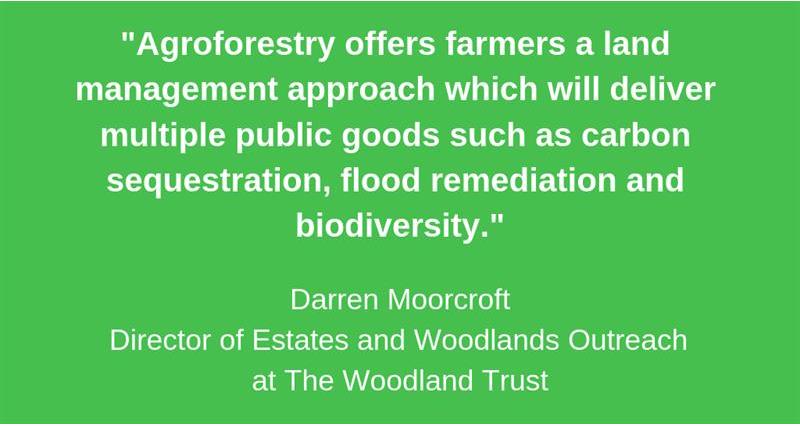Agroforestry should be part of every farmer’s tool box. By deliberately integrating trees and shrubs into crop and livestock systems farm productivity, resilience and the health of the environment can be improved. Agroforestry can be designed to avoid potential trade-offs between food production and other public goods that occur in many modern farming systems.
Trees for increased productivity
Farmer Stephen Briggs’ agroforestry project is bearing fruit in more ways than one. By having a mix of perennials (apple trees) and annuals (cereals) he is growing more produce from the same area, managing risk against climate change and enhancing nature. Why did Stephen do this? As a new tenant he was horrified when his fine grade one soils were being blown off his farm. The single rows of apple trees in 24 metre alleys which were left for cereal production immediately started to act as effective windbreaks.
Planted back in 2009 the fruit yield per hectare is equal to that of the arable crop with a gross margin of c£1000/ha. Stephen is improving the resilience of his business by growing another income earning crop and one that allows him to add value. He recently opened the Harvest Barn farm shop & café where he sells home grown apple juice.
This type of agroforestry helps maximise productivity through three dimensional farming. His arable crops primarily use water, nutrients and sunlight in spring and early summer, whereas the trees need these resources right through to late autumn. Tree roots gather nutrients and water from deep in the soil, benefiting both crops. The canopy protects the annual crop from extremes of weather. Tree height enables this system to use another dimension of space above the ground enabling maximum energy to be captured from sunlight and turned into food. The tree rows under sown with wildflower mixes provide important habitat for pollinators and beneficial insects.
Not all farmers will want to introduce trees as an extra crop. Agroforestry, or put more simply trees integrated into farming systems, comes in many forms from alley cropping to hedges and from shelter belts to in-field trees. Well positioned shelter belts and hedges will improve farm productivity and resilience. Adequate shade and shelter will enhance livestock performance by helping them to maintain a positive energy balance. If too cold, animals burn more energy to survive and need more food, if too warm, they tend to eat less and seek shade. The sheltering effects of trees will also enhance grass growth by helping to warm the soil at beginning and end of the growing season. This will improve crop water efficiency by reducing wind speed and evapotranspiration losses, acting as an insurance policy in times of drought.
Take newly appointed NFU Staffordshire Chairman Richard Bower who has adopted agroforestry on his traditional mixed family farm of arable crops and 250 commercial beef cattle. His reasons being to protect our soils, improve our landscape and provide cover for our grazing animals.
“Embracing Agroforestry is a tool for farmers doing their part to mitigate against and adapt to climate change” says Richard Bower, “working with the Woodland Trust has been easy, their team are professional, practical and well informed.”
Delivering public goods
As well as enhancing productivity, agroforestry can be an important tool in helping the sector meet its commitment to net zero agriculture by 2040. Alongside carbon sequestration, agroforestry will boost the biodiversity of farms, improve landscape character and capture air pollutants such as ammonia. The trees also have a role to play in water management, protecting water quality from pollutants and helping to slow the flow by improving the infiltration of water into the soil.
Will farmers adopt agroforestry?
Although it is an excellent example of integrated land use in action only 3.3% of useable agricultural land in the UK is in agroforestry[1]. Historically farming and forestry have largely been seen as separate industries with little transfer of skills and knowledge. To become a mainstream activity, farmers need accessible and high quality advice and examples of best practice. It also needs the support of Government policy.
Will future Government policy support agroforestry?
It should. Agroforestry offers farmers a land management approach which will deliver multiple public goods such as carbon sequestration, flood remediation and biodiversity. But farmers need tree planting and management to be recognised in the new Agricultural Bill and to be central to the UK’s new environmental land management (ELM) scheme where farmers will be rewarded for delivering public goods. Which, at the moment, we have not received assurances it will be. This is despite the latest Climate Change Committee Report highlighting agroforestry as a mitigation solution to climate change.
If you want to find out how agroforestry could work for your farm contact the Woodland Trust. We can provide advice and support to make it happen. https://www.woodlandtrust.org.uk/plant-trees/large-scale/
Secondly, if you agree that agroforestry should be central to the Agricultural Bill and ELM please tell your local MP and industry leaders. Share a copy of our Agroforestry in England policy briefing.
Let’s ensure the future of farming is sustainable: a future that includes trees in the land use mix.
[1] Den Herder et al., (2017)
